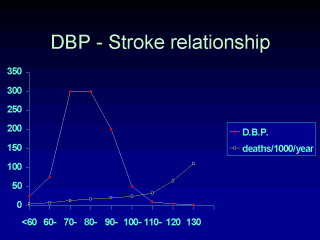 |
This chart shows
the relationship between the population distribution of Diastolic Blood Presssure (DBP)
and the incidence (number of new events / unit of time) of stroke. As you can see, there
is no point at which stroke suddenly becomes much more likely. Instead it increases in a
smooth geometric fashion, but the higher DBP is the greater the incidence, and therefore
individual risk, that stroke will occur. This isn't really very surprising and is the case
with many different biological measures of disease. However, the problem
arises when, as a doctor, you have to make a decision to treat or not, the raised blood
pressure. This is a problem because most treatments are not benign. That is, treatments
carry a risk (of complications, side-effects, loss of quality of life, and in some cases
even death). The doctor is then faced with the complex decision of determining the point
at which treatment risk is less than risk from stroke. You can probably prevent almost all
cases of stroke by screening all people and treating anyone with a DBP >60 mmHg.
However, most of those people you treat would never have had a stroke anyway. The number
needed to treat (NNT) (number of people that are needed to be treated to prevent one
occurrence of the problem) would be very high. The higher the NNT, the less cost-effective
is the treatment. It would cost such a great deal, both financially and in terms of loss
of quality of life (QoL) that it would be quite unacceptable to do so. Instead, an
arbitrary decision is made to choose the cut-off point at 90mmHg because thereafter risk
of stroke rises increasingly steeply and only a minority of patients would have a DBP of
this value or greater. |
